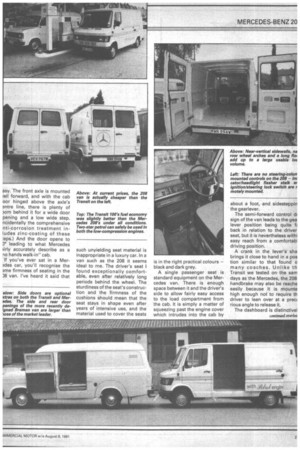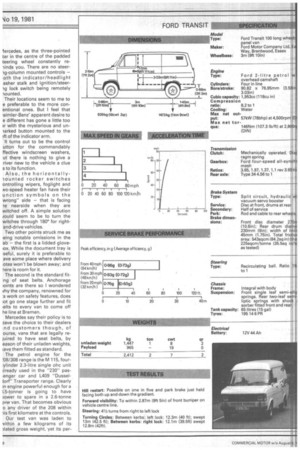Bremen panel beate
Page 20

Page 21

Page 22

Page 23

If you've noticed an error in this article please click here to report it so we can fix it.
Tim Blakemore concludes that the short wheelbase Bremen panel van can't be beat for toughness, paciness and drive appeal — and it's cheaper than the Transit into the bargain
IS interesting to compare anufacturers' strategies in atking certain sectors of the itish commercial vehicle mart. Take the non car-derived in sector for example.
In May this year, Renault unched its Master and Trafic nges (Master road tests (CM, ily 18), and Trafic test to be 'Wished August 29) both with unprecedented range of opals and announced that the hides would be sold mainly rough Renault's car dealer net)rk.
Mercedes-Benz' policy in the same sector of the market has, been totally different. The introduction of various models has been phased-in over a long period and of course the car and commercial vehicle business has been kept separate.
From 1977 when the 207D/307D Bremen range was. launched in Britain until April this year, M-B was in the unusual position of offering only diesel-engined vans in the 2.6tonne to 3.5-tonne gvw class. The factory simply could not produce enough petrol-engined vans to satisfy worldwide demand.
So a toehold, and a substantial one, in the British market was established with diesel-engined vans and chassis cabs only. The subject of our van road test this week is one of the five 208/308 petrol-engined models introduced in April with the aim of turning that toehold into a much more secure foothold. Our test vehicle was a short wheelbase 2.6-tonne gvw 208 van fitted with the option of a side-loading door. The four other models in the petrol-engined range are a longer wheelbase 208 van with a gvw of 2.8 tonnes, a 3.5-tonne gvw 308 van, and two 3.5-tonne gvw chassis cabs — one long and one short wheelbase.
Everything about the 208 van said "quality" to me, from the excellent factory paint finish to such detail as the neat plasticmounted coathooks in the cab. When you slam the doors on the Mercedes, the solid "clunk" enhances the quality image. If you notice a rattle as you drive along, it's likely to be because you haven't closed a door properly rather than because of an ill-fitting component. Styling is a subjective matt and one that is of little conce to many commercial vehic operators, but van users are notable exception. Goodwill ca be generated for so many sm businesses by attractive-lookin vans. I think few operato would disagree with my opinio that the lines of the Bremen va range are pleasing to the e and certainly offer plenty scope for imaginative sig writing.
At the same time, the shape the van body is eminently pract cal. The side walls are almo vertical, having much less curv ture than comparable For Transit or Bedford van model; for example. Single rear wheel keep the wheel arch intrusio into the load space to minimum — there is a clea 1,245mm (49in) of floor spac between them.
Furthermore, they are flai topped, preferable to th rounded variety for most opere tions.
When open, both the rez. doors and optional sliding sid door leave large unobstructe door apertures so that the mol can be made of the large loa volume: 7cum (247cuft) usin the DIN standard measurin method, Also the channel se■ tion internal strengthening rib for the van walls are shallow an so encroach only a little into th load volume.
The horizontal ribs fitted at th van's waist height have ova shaped slots cut into then These holes look as if they al intended for some kind of loac retention device, and indeed ca be used for securing loose loac with rope, but Daimler-Benz . Stuttgart tell us that their prin ary function is to allow for th application of corrosion inhib tors during construction.
Access to the driver's seat the Bremen van is superb asy. The front axle is mounted fell forward, and with the cab oor hinged above the axle's antre line, there is plenty of )om behind it for a wide door pening and a low wide step. ncidentally the comprehensive nti-corrosion treatment inludes zinc-coating of these :eps.) And the door opens to 3° leading to what Mercedes lirly accurately describe as a io hands walk-in" cab.
If you've ever sat in a Mer?des car, you'll recognise the )me firmness of seating in the 38 van. I've heard it said that such unyielding seat material is inappropriate in a luxury car. In a van such as the 208 it seems ideal to me. The driver's seat I found exceptionally comfortable, even after relatively long periods behind the wheel. The sturdiness of the seat's construction and the firmness of the cushions should mean that the seat stays in shape even after years of intensive use, and the material used to cover the seats is in the right practical colours black and dark grey.
A single passenger seat is standard equipment on the Mercedes van. There is enough space between it and the driver's side to allow fairly easy access to the load compartment from the cab. It is simply a matter of squeezing past the engine cover which intrudes into the cab by about a foot, and sidesteppin the gearlever.
The semi-forward control dI sign of the van leads to the gea lever position being quite :N back in relation to the driver seat, but it is nevertheless withi easy reach from a comfortabl driving position.
A crank in the lever's sha brings it close to hand in a pos tion similar to that found o many coaches. Unlike th Transit we tested on the sam days as the Mercedes, the 208 handbrake may also be reache easily because it is mounte high enough not to require th driver to lean over at a prec rious angle to release it.
The dashboard is distinctivel continued overlea
lercedes, as the three-pointed tar in the centre of the padded Leering wheel constantly re-lire:Is you. There are no steerig-column mounted controls — oth the indicator/headlight asher stalk and ignition/steerlig lock switch being remotely iounted.
Their locations seem to me to
e preferable to the more conentional ones. But I feel that aimler-Benz' apparent desire to e different has gone a little too )r with the mysterious and unlarked button mounted to the )11 of the indicator arm.
It turns out to be the control utton for the commendably ffective windscreen washers, ut there is nothing to give a river new to the vehicle a clue s to its function.
Also, the horizontally-taunted rocker switches ontrolling wipers, foglight and No-speed heater fan have their unction symbols on the wrong" side — that is facing le nearside when they are witched off. A simple solution muld seem to be to turn the witches through 1800 for rightand-drive vehicles.
Two other points struck me as ieing notable omissions in the ab — the first is a lidded glovepox. While the document tray is seful, surely it is preferable to ave some .place where delivery lotes won't be blown away; and nere is room for it.
The second is the standard Ming of seat belts. Anchorage ioints are there so I wondered
w hy the company, renowned for ;s work on safety features, does lot go one stage further and fit ielts to every van to come off he line at Bremen.
Mercedes say their policy is to 3ave the choice to their dealers Ind customers though, of ourse, vans that are legally reluired to have seat belts, by eason of their unladen weights, lave them fitted as standard. The petrol engine for the I08/308 range is the M 115, fourylinder 2.3-litre single ohc unit ilready used in the "230" pasanger car car and L409 "Dussellorf" Transporter range. Clearly in engine powerful enough for a I.5-tonner is going to have )ower to spare in a 2.6-tonne ivw van. That becomes obvious
o any driver of the 208 within us first kilometre at the controls. Our test van was laden to vithin a few kilograms of its )Iated gross weight, yet its per
formance was almost as livel), you would expect from an ur den vehicle. The first 208s to imported were fitted with a 4. rear axle ratio giving a rm mum geared speed of 114kn (71mph) and a remarkal rolling gradeability of 40 cent (1 in 2.5).
Wisely, Mercedes-Benz ff. Ltd has opted for a lower r axle ratio (higher geared spe on the latest 208s. Our test had this 4.4:1 ratio and an act top speed allowing for the snlest of speedometer errors, 130km/h (81mph).
Its gradeability was still ml than adequate even for the m hilly of routes. Our van j about managed a restart or one in three test hill.
Summary
When comparing any Fc Transit with its competitors, always difficult to be sure tl the comparison is on a like like basis. There are so mz models in the Transit range. 1 most surprising fact to ernet from this comparison was tl the Transit IDOL Custom van actually more expensive tlthe Mercedes 208 short whE base van.
Ford recently increased commercial vehicle prices April) and most Mercedes prir have not been increased sir October but we know of planned imminent rise for Bremen models.
Not so surprisingly, t Transit's two-litre engine v more economical than the ; litre Mercedes under all cor tions. Unladen around CI Thames Valley route, the ; Mercedes van recorded 12 lit/100km (22.83 mpg).
Laden, on a predominar motorway route between No London and MIRA, the 20 consumption fell to 16. lit/100km (17.22 mpg). Althot this Transit's gvw is slightly II than the 208's, the Ford's cont erably lighter kerb weight gi■ it a payload advantage of 21 (0.5 cwt).
From a driver's point of vir the Transit will stand comp. son with any van but the M cedes has even more driver peal. If I had to transport 90( of goods in a hurry over a lc distance, I can think of no ot van that would take preferer over the Mercedes-Benz 208.














































